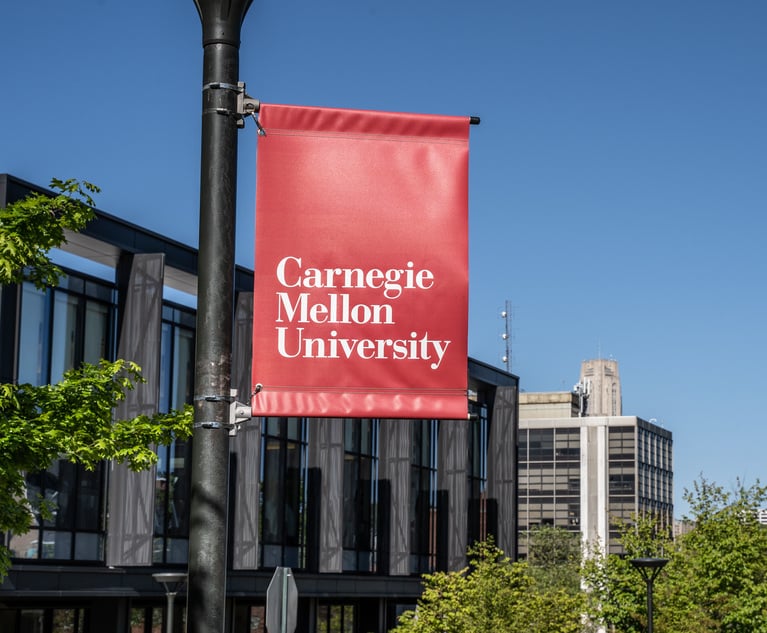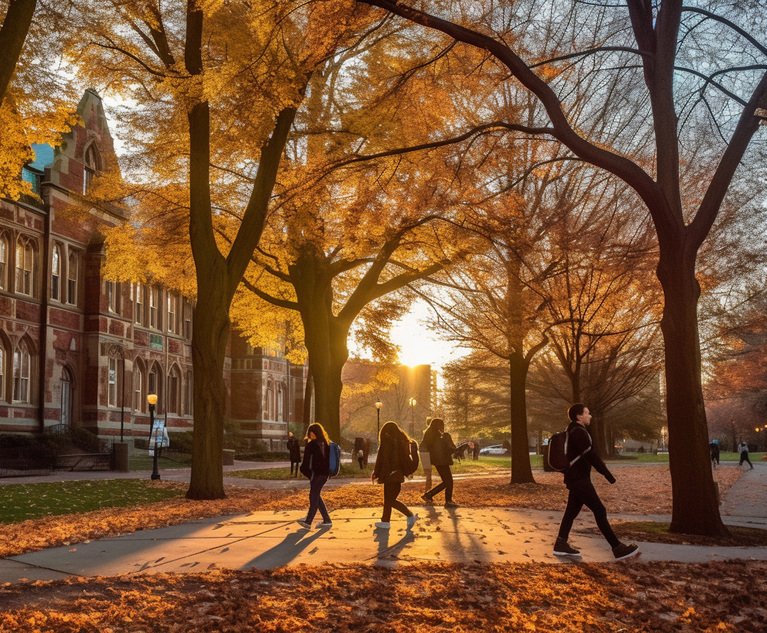Safe2Say Something Program and How It Impacts Schools
At a recent gathering of the national Council of School Attorneys here in Philadelphia, one of our speaker colleagues remarked that what goes on in schools is a reflection of our culture at large.
April 24, 2019 at 12:30 PM
6 minute read
 Michael Puppio Jr., Raffaele Puppio.
Michael Puppio Jr., Raffaele Puppio.
At a recent gathering of the national Council of School Attorneys here in Philadelphia, one of our speaker colleagues remarked that what goes on in schools is a reflection of our culture at large. Sadly, there is no exception when it comes to shootings, other criminal activities and tragic occurrences. With Act 44 of 2018, the legislature created a Safe2Say initiative with the intent to curb school violence and shootings by providing a means by which “students, teachers and community members can report behavior perceived to be threatening to an individual or a school entity.”
This relatively new law applies to all K-12 schools, school districts, charter schools, private schools, cybercharter schools and nonpublic schools. As of Jan. 14, the Pennsylvania Office of Attorney General (OAG) and all Pennsylvania school districts and schools are responsible to implement the mandated Safe2Say Something Program (S2SS). Article XIII-D of Act 44, 24 P.S. 13-1301-D, et seq., sets forth measures by which members of the community may anonymously contact authorities with suspicions or concerns impacting a school community. Tips may be submitted through telephone, app or the website. These reports go directly to a triage team at the OAG that makes the initial determination as to whether the matter involves a threat to life safety or not, based on the information received. Examples of life safety matters include, inter alia, activity that is imminent and in progress, such as an active shooter, gang violence or a planned attack. Nonlife safety matters are a much broader category and may include events such as hate crimes, sexting, alcohol possession, anger issues, eating disorders and inappropriate use of technology. Once a tip is received, the OAG staff must categorize the tip as either life safety or nonlife safety and refer it to the appropriate entities. Life safety tips are referred to 911 dispatch as well as the impacted school, no matter what time they are received. Thus, school officials, like first responders, may receive a call at any time of the day or night. Nonlife safety events are referred to the school between the hours of 6 a.m. and 6 p.m. daily.
The natural question for schools is, what must be done with the referral once it is received by the school? A few of the challenges that arise from the S2SS protocol in the general education setting include the imposition of appropriate discipline, student/parent confidentiality rights with regard to personally identifiable information and the public nature of school records.
Discipline
Under the Pennsylvania Public School Code of 1949, schools have broad discretion to create and enforce rules of conduct and deportment for students and staff, see 24 P.S. Section 5-510. Most schools have enacted policies that generally empower administrators to discipline students and staff to maintain order and promote proper conduct while in school or involved in school-related activities. Student codes of conduct are a common codification of the disciplinary rules and procedures, and frequently include defined levels of infractions (Level I being least severe and Level III or IV being the most severe), and possible discipline that might be imposed at each level.
As schools receive tips from the OAG through the S2SS program, they are able to investigate and impose any necessary discipline according to the school's policies and codes of conduct. The initial question must always be whether the conduct occurred in school or at a school-related function, so that the school can exercise jurisdiction over any discipline. If the conduct is school-related, the school can glean from the anonymous information as much as possible to conduct its own investigation. Finally, in the general education context, if the investigation shows conduct in violation of school rules, discipline may be imposed in accordance with the code of conduct. It should be noted that discipline matters concerning special education students have additional procedural safeguards that must be adhered to before discipline may be imposed.
FERPA
The Family Education Rights and Privacy Act, 20 U.S.C. Section 1232g, generally protects from disclosure personally identifiable information (PII) of a student contained in his or her education records. The aforementioned phrase is very broadly defined to include any records maintained by a school that pertain to a student. Generally, without parental consent (or the student if the student has reached age 18) PII cannot be released by the school. There are a number of exceptions to the general rule where a school can release PII without first obtaining parent/student consent. One such exception is where there exists a health or safety emergency. This is not a broad exception, however. The PII may be disclosed to appropriate parties, in connection with an emergency if knowledge of the information is necessary to protect the health or safety of the student or other individuals. Schools may include in the education records of a student information concerning disciplinary action taken against the student for conduct that posed a significant risk to the safety or well-being of that student, other students or other members of the school community.
This information can be shared internally or externally with other teachers or officials who have legitimate educational interests in the behavior of the student. If the school determines there is an articulable and significant threat to the health or safety of a student or other individuals, it may disclose information from education records to any person who has knowledge of it is necessary to protect the health or safety of the student or other individuals.
Accordingly, schools receiving tips through the OAG's office must be careful as to what information is shared concerning the student who is the subject of the tip, and to whom information is provided.
Right to Know Law
As a general rule, all records of a public entity, such as a school district, are public records that can be obtained and viewed by members of the public, upon request. The Right to Know Law, 65 P. S. Sections 67.101, et seq., requires local agencies to disclose public records. Of course, there are recognized exceptions that exclude certain types of records from the definition of public record. Mindful of this, the legislature expressly declared that “a record created or obtained through the implementation or operation of the S2SS program shall be confidential.” Such records may only be disclosed upon court order following in camera review. To further protect, the “records of the program” from disclosure, the legislature expressly made them not subject to the Right to Know Law.
Thus, records created by the OAG's office, law enforcement and the schools will be confidential and not subject to distribution to the public. No doubt, this fact will be problematic for media and community awareness groups and perhaps subject to challenge as the new program matures.
Michael V. Puppio Jr., a founding partner of Raffaele Puppio, concentrates his practice in the areas of education law, municipal law, municipal finance and litigation. He is the solicitor for many school districts and municipalities throughout southeast Pennsylvania.
This content has been archived. It is available through our partners, LexisNexis® and Bloomberg Law.
To view this content, please continue to their sites.
Not a Lexis Subscriber?
Subscribe Now
Not a Bloomberg Law Subscriber?
Subscribe Now
NOT FOR REPRINT
© 2025 ALM Global, LLC, All Rights Reserved. Request academic re-use from www.copyright.com. All other uses, submit a request to [email protected]. For more information visit Asset & Logo Licensing.
You Might Like
View All
LSAT Administrator Sues to Block AI Tutor From Using ‘Famous, Distinctive’ Test Prep Materials
3 minute read
Disjunctive 'Severe or Pervasive' Standard Applies to Discrimination Claims Against University, Judge Rules
5 minute read
From 'Confusing Labyrinth' to Speeding 'Roller Coaster': Uncertainty Reigns in Title IX as Litigators Await Second Trump Admin
6 minute readTrending Stories
- 1'It's Not Going to Be Pretty': PayPal, Capital One Face Novel Class Actions Over 'Poaching' Commissions Owed Influencers
- 211th Circuit Rejects Trump's Emergency Request as DOJ Prepares to Release Special Counsel's Final Report
- 3Supreme Court Takes Up Challenge to ACA Task Force
- 4'Tragedy of Unspeakable Proportions:' Could Edison, DWP, Face Lawsuits Over LA Wildfires?
- 5Meta Pulls Plug on DEI Programs
Who Got The Work
Michael G. Bongiorno, Andrew Scott Dulberg and Elizabeth E. Driscoll from Wilmer Cutler Pickering Hale and Dorr have stepped in to represent Symbotic Inc., an A.I.-enabled technology platform that focuses on increasing supply chain efficiency, and other defendants in a pending shareholder derivative lawsuit. The case, filed Oct. 2 in Massachusetts District Court by the Brown Law Firm on behalf of Stephen Austen, accuses certain officers and directors of misleading investors in regard to Symbotic's potential for margin growth by failing to disclose that the company was not equipped to timely deploy its systems or manage expenses through project delays. The case, assigned to U.S. District Judge Nathaniel M. Gorton, is 1:24-cv-12522, Austen v. Cohen et al.
Who Got The Work
Edmund Polubinski and Marie Killmond of Davis Polk & Wardwell have entered appearances for data platform software development company MongoDB and other defendants in a pending shareholder derivative lawsuit. The action, filed Oct. 7 in New York Southern District Court by the Brown Law Firm, accuses the company's directors and/or officers of falsely expressing confidence in the company’s restructuring of its sales incentive plan and downplaying the severity of decreases in its upfront commitments. The case is 1:24-cv-07594, Roy v. Ittycheria et al.
Who Got The Work
Amy O. Bruchs and Kurt F. Ellison of Michael Best & Friedrich have entered appearances for Epic Systems Corp. in a pending employment discrimination lawsuit. The suit was filed Sept. 7 in Wisconsin Western District Court by Levine Eisberner LLC and Siri & Glimstad on behalf of a project manager who claims that he was wrongfully terminated after applying for a religious exemption to the defendant's COVID-19 vaccine mandate. The case, assigned to U.S. Magistrate Judge Anita Marie Boor, is 3:24-cv-00630, Secker, Nathan v. Epic Systems Corporation.
Who Got The Work
David X. Sullivan, Thomas J. Finn and Gregory A. Hall from McCarter & English have entered appearances for Sunrun Installation Services in a pending civil rights lawsuit. The complaint was filed Sept. 4 in Connecticut District Court by attorney Robert M. Berke on behalf of former employee George Edward Steins, who was arrested and charged with employing an unregistered home improvement salesperson. The complaint alleges that had Sunrun informed the Connecticut Department of Consumer Protection that the plaintiff's employment had ended in 2017 and that he no longer held Sunrun's home improvement contractor license, he would not have been hit with charges, which were dismissed in May 2024. The case, assigned to U.S. District Judge Jeffrey A. Meyer, is 3:24-cv-01423, Steins v. Sunrun, Inc. et al.
Who Got The Work
Greenberg Traurig shareholder Joshua L. Raskin has entered an appearance for boohoo.com UK Ltd. in a pending patent infringement lawsuit. The suit, filed Sept. 3 in Texas Eastern District Court by Rozier Hardt McDonough on behalf of Alto Dynamics, asserts five patents related to an online shopping platform. The case, assigned to U.S. District Judge Rodney Gilstrap, is 2:24-cv-00719, Alto Dynamics, LLC v. boohoo.com UK Limited.
Featured Firms
Law Offices of Gary Martin Hays & Associates, P.C.
(470) 294-1674
Law Offices of Mark E. Salomone
(857) 444-6468
Smith & Hassler
(713) 739-1250






